FLASH Research : Evolution of mental health indicators in the first three cycles of ELOSMET study.
This FLASH Research presents the preliminary results of the evolution of mental health symptoms among the 6602 people from 95 workplaces who participated in the Longitudinal Study of the Observatory on Health and Well-Being at Work (ELOSMET). This is an online survey started in 2019 that is repeated every year for five years. It addresses several dimensions of health and well-being at work, as well as a set of working conditions, life situations outside of work and personal characteristics.
Cycle 1 data collection covers the period 2019-2021 (n=3024), Cycle 2 2020-2022 (n=3501) and Cycle 3 2021-2023 (n=2945). The response rate varied between 36.7% and 44.9% depending on the cycle. The following table presents the main socio-demographic and work environment characteristics of this sample.
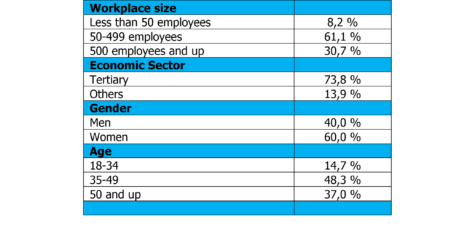
The following questionnaires were used:
- Psychological Distress: Minor psychiatric disorders (depressive symptoms, anxiety, irritability, cognitive problems) not specific to a particular disease. Score of 4 and above on the General Health Questionnaire (GHQ-12).1
- Depression (measured from Cycle 2): Scores of 10 and greater (moderate and greater symptoms) on the Patient Health Questionnaire (PHQ-9).2
- Anxiety (measured from Cycle 2): Score of 10 or more (moderate and more severe symptoms) on the General Anxiety Disorder (GAD-7).3
- Burnout: Fatigue, physical and psychological exhaustion perceived by the person as being related to his work. Score of 50 and above (moderate symptoms and above) on the Copenhagen Burnout Inventory (CBI-7).4
- Consumption of psychotropic drugs: Consumption in the past month of at least one medication such as tranquilizers (e.g., diazepam, Valium), antidepressants (e.g., fluoxetine, Prozac), opiates (e.g., codeine, Ratio-Lenoltec #3), or sleeping pills (e.g.: zopiclone, Imovane).
Figure 1 presents the general evolution of the five mental health indicators.
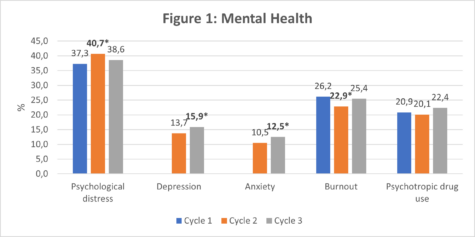
Note: * The differences with Cycle 1 (Cycle 2 for depression and anxiety) are significant at p < 0.05.
Figures 2 to 6 present the evolution of mental health indicators according to gender and age.
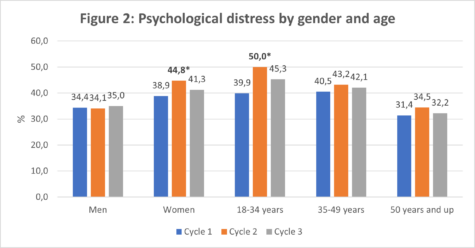
Note: * The differences with Cycle 1 are significant at p < 0.05.
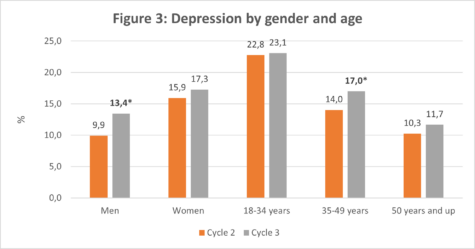
Note: * The differences with Cycle 2 are significant at p < 0.05.
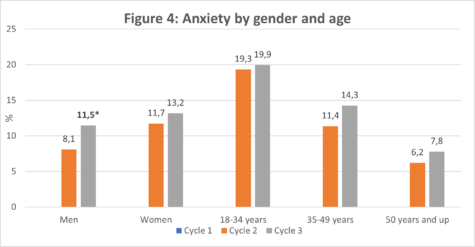
Note: * The differences with Cycle 2 are significant at p < 0.05.
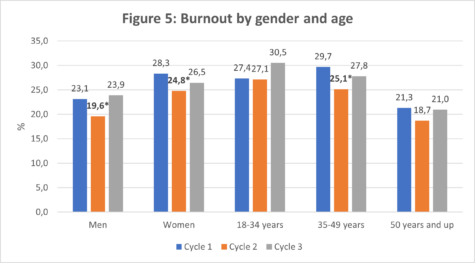
Note: * The differences with Cycle 2 are significant at p < 0.05.
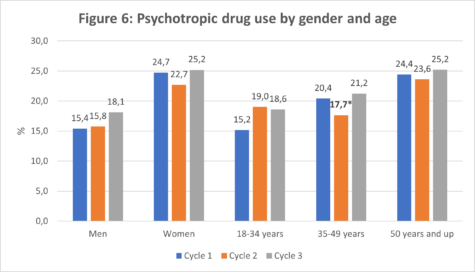
Note: * The differences with Cycle 2 are significant at p < 0.05.
The findings are as follows:
- Globally,
- Psychological distress increased between Cycle 1 and Cycle 2, but in Cycle 3, it returns to the level observed for Cycle 1.
- Burnout decreased between Cycle 1 and Cycle 2, but in Cycle 3 it returns to the level observed for Cycle 1.
- The prevalence of depression and anxiety symptoms increases from Cycle 2 to Cycle 3.
- The psychotropic drugs use remains stable between cycles.
- For differences by gender and age,
- Women and people aged 18-34 experienced an increase in psychological distress between Cycle 1 and Cycle 2, but in Cycle 3 it returns to the level observed for Cycle 1.
- Men and people aged 35-49 report an increase in depression symptoms between Cycle 2 and Cycle 3.
- Men report an increase in anxiety symptoms between Cycle 2 and Cycle 3.
- Burnout decreased between Cycle 1 and Cycle 2 for men, women and people aged 35-49.
- The psychotropic drugs use decreased between Cycle 1 and Cycle 2 for people aged 35-49.
Conclusion
ELOSMET study has already documented that mental health problems among employed people in this sample are significant and vary according to gender and age5,6. Closing on Cycle 3, and for all respondents, psychological distress affects 38.6% of people, 12.5%-15.9% report symptoms of depression or anxiety, 25.4% burnout and 22.4% use psychotropic drugs. The situation of women and younger people are still worrying.
When examining the evolution of these damages over time, psychological distress and burnout seem to have been influenced by the conditions related to the COVID-19 pandemic, which manifests mainly starting from Cycle 2. However, the ELOSMET data suggests that these variations were associated with its period, as the indicators return to pre-pandemic levels in Cycle 3. The effects associated with confinement, the fear of contamination and the obligation of teleworking for several people seem to be diluted over time with the control of contamination and the return to work in-person or in a hybrid mode.
Psychotropic drugs use does not seem to have been particularly affected by the disruptions linked to the pandemic. However, the increase in depressive and anxious symptoms observed in men between Cycle 2 and Cycle 3, as well as the symptoms of depression in people aged 35-49, is intriguing. Analyzes will be necessary to explain these variations, but it is possible to consider a greater difficulty for men to return to a work situation which involves constraints and requirements related to travel to get to work, and for people aged 35- 49 years a return to greater difficulties in balancing work-family and personal life.
The results presented here will be updated periodically.
References
- McDowell, I. & Newell, C. (1996) Measuring health: a guide to rating scales and questionnaires, 2nd ed. Oxford University Press, New York
- Kroenke, K., Spitzer, R. L. & Williams, J. B. W. (2001). The PHQ-9: Validity of a brief depression severity measure. J Gen Intern Med, 16(9), 606-613.
- Spitzer, R. L., Kroenke, K., Williams, J. B. W. & Löwe, B. (2006). A brief measure for assessing generalized anxiety disorder: The GAD-7. Archives of Internal Medicine, 166(10), 1092-1097.
- Kristensen, T.S., Borritz, M., Villadsen, E. & Christensen, K.B. (2005) The Copenhagen Burnout Inventory: A new tool for the assessment of burnout, Work & Stress, 19(3), 192-207.
- Observatoire sur la santé et le mieux-être au travail (2022). FLASH Recherche : Prévalence des problèmes de santé mentale en milieux de travail pendant la COVID-19 : les résultats du Cycle 2 de l’ELOSMET. Université de Montréal. https://osmet.openum.ca/en/flash-recherche-prevalence-des-problemes-de-sante-mentale-en-milieux-de-travail-pendant-la-covid-19-les-resultats-du-cycle-2-de-lelosmet/
- Observatoire sur la santé et le mieux-être au travail (2021). FLASH Recherche : Importance des problèmes de santé mentale en milieux de travail avant et pendant la crise de la COVID-19 : Les premiers résultats du Cycle 1 de l’ELOSMET. Université de Montréal. https://osmet.openum.ca/en/flash-recherche-la-sante-mentale-en-milieux-de-travail-en-temps-de-pandemie/
Website: www.osmet.umontreal.ca/en/home/
About OSMET
The Observatory on Occupational Health and Well-Being (OSMET) was born out of a collaboration with the Faculty of Arts and Sciences, the Public Health Research Institute (now the Public Health Research Center) and the School of Industrial Relations of the University of Montreal. OSMET benefits from the financial support of three partners: TELUS Health, Medavie and Pratt & Whitney Canada.
This content has been updated on 19 July 2023 at 2h17.
